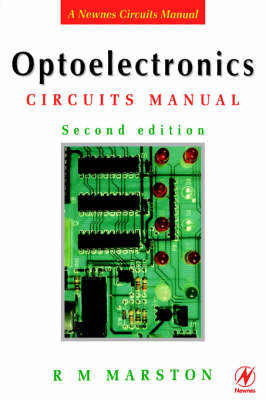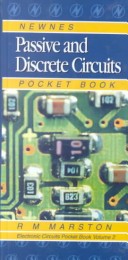Circuit manuals
7 total works
The CMOS Cookbook contains all you need to know to understand and successfully use CMOS (Complementary Metal-Oxide Semiconductor) integrated circuits. Written in a "cookbook" format that requires little math, this practical, user-oriented book covers all the basics for working with digital logic and many of its end appilations.
Whether you're a newcomver to logic and electronics or a senior design engineer, you'll find CMOS Cookbook and its examples helpful as a self-learning guide, a reference handbook, a project-idea book, or a text for teaching others digital logic at the high school through university levels.
In the pages of this revised edition, you'll discover:
*What CMOS is, who makes it, and how the basic transistors, inverters, and logic and transmission gates work
*CMOS usage rules, power-suppy examples, and information on breadboards, state testing, tools, and interfacing
*Discussions of the latest CMOS devices and sub-families, including the 74C, 74HC, and 74HCT series that streamline TTL and CMOS interfacing
*An in-depth look at multivibrators - including astable, monostable, and bistable - and linear techniques
*Clocked-logic designs and the extensive applications of JK and D-type flip-flops
*A helpful appendix featuring a TTL-to-CMOS conversion chart
Whether you're a newcomver to logic and electronics or a senior design engineer, you'll find CMOS Cookbook and its examples helpful as a self-learning guide, a reference handbook, a project-idea book, or a text for teaching others digital logic at the high school through university levels.
In the pages of this revised edition, you'll discover:
*What CMOS is, who makes it, and how the basic transistors, inverters, and logic and transmission gates work
*CMOS usage rules, power-suppy examples, and information on breadboards, state testing, tools, and interfacing
*Discussions of the latest CMOS devices and sub-families, including the 74C, 74HC, and 74HCT series that streamline TTL and CMOS interfacing
*An in-depth look at multivibrators - including astable, monostable, and bistable - and linear techniques
*Clocked-logic designs and the extensive applications of JK and D-type flip-flops
*A helpful appendix featuring a TTL-to-CMOS conversion chart
This book is a guide to the wide range of audio and audio-associated integrated circuits (ICs) which are available for use by amateur and professional design engineers and technicians. The book deals with low frequency linear amplifiers, dual pre-amplifiers, audio power amplifiers, charged-coupled delay lines, bar-graph display drivers and power supply regulators and shows how to use these devices in circuit ranging from simple signal conditioners and filters to complex graphic equalizers, stero amlifier systems and echo/reverb delay line systems. Each chapter deals with a specific class of IC and starts off by explaining the basic principles of the subject and goes on to present a more in-depth look, including practical ICs and their applications. The book is specifically aimed at the practical design engineer, technician and experimenter, as well as the electronics student and amateur. R.M.Marston is also the author of "CMOS Circuits Manual" and "Optoelectronic Circuits Manual".
Optoelectronics Circuits Manual is a useful single-volume guide specifically aimed at the practical design engineer, technician, and experimenter, as well as the electronics student and amateur. It deals with the subject in an easy to read, down to earth, and non-mathematical yet comprehensive manner, explaining the basic principles and characteristics of the best known devices, and presenting the reader with many practical applications and over 200 circuits. Most of the ICs and other devices used are inexpensive and readily available types, with universally recognised type numbers.
The second edition has been revised to include new and developing technologies such as PIR movement detectors and fibre-optic data links. In addition, components no longer in production have been replaced with parts that are easily available from major suppliers.
The second edition has been revised to include new and developing technologies such as PIR movement detectors and fibre-optic data links. In addition, components no longer in production have been replaced with parts that are easily available from major suppliers.
This book is concerned mainly with waveform generator techniques and circuits. Waveform generators are used somewhere or other in most types of electronic equipment, and thus form one of the most widely used classes of circuit. They may be designed to produce outputs with sine, square, triangle, ramp, pulse, staircase or a variety of other forms. The generators may produce modulated or unmodulated outputs, and the outputs may be of single or multiple form. Waveform generator circuits may be built using transistors, op-amps, standard digital ICs, or dedicated waveform or 'function' generator ICs. One of the most popular ways of generating square and pulse waveforms is via so-called "time" ICs of the widely available and versatile "555" type, and many circuits of this type are included in the book. The manual is divided into eleven chapters and presents a total of over three hundred practical circuits, diagrams and tables. The opening chapter outlines basic principles and types of generator. Chapters 2 to 8 each deal with a specific type of waveform generator and chapter nine deals with special waveform generator circuits.
Chapter ten takes an in-depth look at phase-locked loop circuits, and the final chapter deals with miscellaneous applications of the ubiquitous "555" timer type of IC. An appendix presents a number of useful waveform-generator design charts, as an aid to those readers who wish to design or modify generator circuits to their own specifications. The book is specifically aimed at the practical design engineer, technician and experimenter, but will be of equal interest to the electronics student and the amateur. It deals with its subject in an easy-to-read, down-to-earth, non-mathematical but very comprehensive manner. Each chapter starts off by explaining the basic principles of its subject and then goes on to present the reader with a wide range of practical circuit designs. Throughout the volume, great emphasis is placed on practical "user" information and circuitry, and the book abounds with useful circuits and data. Most of the ICs and other devices used in the practical circuits are modestly priced and readily available types, with universally recognized type numbers.
Chapter ten takes an in-depth look at phase-locked loop circuits, and the final chapter deals with miscellaneous applications of the ubiquitous "555" timer type of IC. An appendix presents a number of useful waveform-generator design charts, as an aid to those readers who wish to design or modify generator circuits to their own specifications. The book is specifically aimed at the practical design engineer, technician and experimenter, but will be of equal interest to the electronics student and the amateur. It deals with its subject in an easy-to-read, down-to-earth, non-mathematical but very comprehensive manner. Each chapter starts off by explaining the basic principles of its subject and then goes on to present the reader with a wide range of practical circuit designs. Throughout the volume, great emphasis is placed on practical "user" information and circuitry, and the book abounds with useful circuits and data. Most of the ICs and other devices used in the practical circuits are modestly priced and readily available types, with universally recognized type numbers.
A single-volume guide to linear ICs available for use to both amateur and professional design engineers and technicians. Chapters deal with specific types of IC or class of circuit, discussing basic principles and the range of applications possible for circuits and tables. Concise and easy-to-read, the book places emphasis on practical "user" information and circuitry. Topics discussed include transistor "array" ICs, op-amp circuits, audio ICs, "hybrid" ICs and radio, reference and sensor ICs. Other in this series and by this author include "Audio IC Circuits Manual", "CMOS Circuits Manual", "Electronic Alarm Circuits Manual", "Op-amp Circuits Manual", "Optoelectronics Circuits Manual" and Power Control Circuits Manual".
This book explains the workings and applications of the operational amplifier, one of the most popular and versatile building-blocks used in modern electronic circuit design. The ten chapters cover the operating principles and the special types of op-amp, and there are some 300 practical circuits, diagrams and tables. The book is intended for the practical design engineer, technician and experimenter, but should also interest the electronics student and the amateur. The language used throughout is easy-to-understand and non-mathematical.


